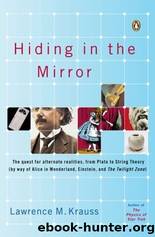Hiding in the Mirror: The Quest for Alternate Realities, from Plato to String Theory by Lawrence Krauss

Author:Lawrence Krauss
Language: eng
Format: azw3, mobi, epub
Tags: Non-Fiction, Science, Philosophy, Mathematics, Physics, Popular Science, History
ISBN: 9780143038023
Publisher: Penguin Group US
Published: 2005-10-19T13:00:00+00:00
so too, you could imagine unfolding a tesseract and projecting onto a three-dimensional space the eight cubes that form its surface:
This projection, which is also called a ânet,â was Tealâs constructionâthat is, until an earthquake accidentally causes the structure to fold back up into its four-dimensional form, nearly trapping Teal and the new owners in another three-dimensional space forever removed from our own.
Heinleinâs fascination with hypercubes was not novel. Charles Hintonâs fixation with four dimensions caused him to imagine and present a host of ways of visualizing four-dimensional objects such as tesseracts (or hypercubes, as they are also known) in all of his many writings at the turn of the last century. In the 1920s short stories continued to focus on the fourth dimension as a way to move in and out of interesting three-dimensional spaces. Both Richard Hughesâs humorous âThe Vanishing Manâ (1926) and Miles Breuerâs âThe Appendix and the Spectaclesâ (1928) focus on the opportunities and problems that result from the fact that moving into a fourth spatial dimension would allow one to visit and explore the insides of objects, including human beings, without ever having to actually travel through their outer surfaces. But I suspect it was Heinleinâs work (in particular âCrooked Houseâ) and later writing (such as Madeline LâEngleâs childrenâs classic A Wrinkle in Time, in which a tesseract is used as a portal to reach faraway distances and times in a folded space) that brought the idea to popular attention, and made the term tesseract a familiar one in popular culture. (Heinlein continued his fascination with a fourth dimension up through his 1963 story âGlory Road,â which involved a hyperdimensional packing case that was bigger inside than outside.)
Coincidentally, at almost the same time as Heinleinâs and Mathesonâs work was permeating popular culture, one of the twentieth centuryâs most prolific and imaginative artists, Salvador Dali, who had moved well beyond cubism to help spearhead surrealism, produced his classic painting, Crucifixion, Corpus Hypercubus, which reproduces the tesseract net I displayed earlier.
While modern art has itself moved well beyond surrealism, so that concern with the three-dimensional notion of form has been replaced by such interests as colorâor in the most extreme forms of conceptual art, no form at allâthe inclusion in 1954 of a tesseract as a surrealist object of interest is part of a pattern in popular culture that I find particularly intriguing. Recall that, at the turn of the century, before, during, and immediately after the introduction of Einsteinâs work, fascination with a fourth spatial dimension existed entirely independently of special relativity. Yet almost a half-century after Einsteinâs revolutionary theories, the notion that the fourth dimension of that theory was not a spatial dimension still had not fully filtered down to the popular level. Or alternatively, even if it had, the recognition of our existence within a four-dimensional space-time continued to inspire at least a hope that other spatial dimensions might actually exist.
In particular, in both Mathesonâs story and Heinleinâs, and in much other contemporaneous writingâsuch
Download
Hiding in the Mirror: The Quest for Alternate Realities, from Plato to String Theory by Lawrence Krauss.mobi
Hiding in the Mirror: The Quest for Alternate Realities, from Plato to String Theory by Lawrence Krauss.epub
This site does not store any files on its server. We only index and link to content provided by other sites. Please contact the content providers to delete copyright contents if any and email us, we'll remove relevant links or contents immediately.
The remains of the day by Kazuo Ishiguro(8817)
Tools of Titans by Timothy Ferriss(8215)
Giovanni's Room by James Baldwin(7188)
The Black Swan by Nassim Nicholas Taleb(7010)
Inner Engineering: A Yogi's Guide to Joy by Sadhguru(6723)
The Way of Zen by Alan W. Watts(6504)
Asking the Right Questions: A Guide to Critical Thinking by M. Neil Browne & Stuart M. Keeley(5631)
The Power of Now: A Guide to Spiritual Enlightenment by Eckhart Tolle(5604)
The Six Wives Of Henry VIII (WOMEN IN HISTORY) by Fraser Antonia(5394)
Astrophysics for People in a Hurry by Neil DeGrasse Tyson(5130)
Housekeeping by Marilynne Robinson(4336)
12 Rules for Life by Jordan B. Peterson(4249)
Double Down (Diary of a Wimpy Kid Book 11) by Jeff Kinney(4204)
The Ethical Slut by Janet W. Hardy(4172)
Skin in the Game by Nassim Nicholas Taleb(4161)
Ikigai by Héctor García & Francesc Miralles(4123)
The Art of Happiness by The Dalai Lama(4063)
Skin in the Game: Hidden Asymmetries in Daily Life by Nassim Nicholas Taleb(3929)
Walking by Henry David Thoreau(3892)
